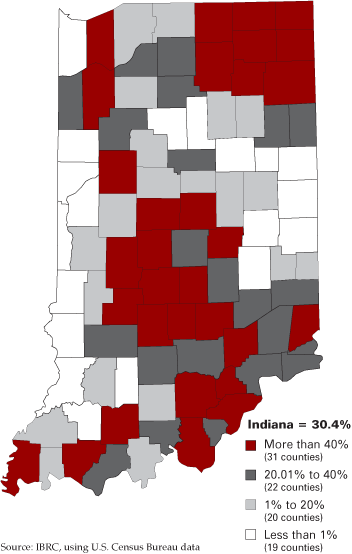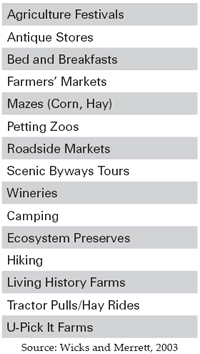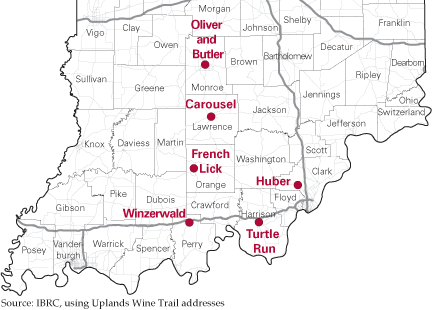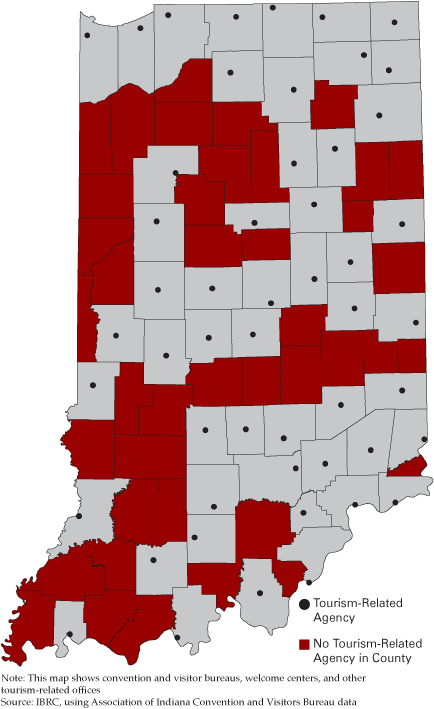Agritourism and Rural Economic Development
Research Associate, Department of Recreation and Sport Management, Indiana State University
Assistant Professor, Department of Recreation and Sport Management, Indiana State University
Indiana’s Office of Tourism Development reports that the state’s “tourism industry brings in approximately $6.7 billion in spending from 58 million leisure visitors.” (1) According to Destination Indiana: Indiana Office of Tourism Development 2006 Strategic Plan, tourism is essential to Indiana’s economy and is growing almost 5 percent annually, which is above the national average. Although tourism has the potential to impact rural economies, many do not have the local capacity or institutions to develop a sustainable tourism system. The basic acknowledgement of tourism’s importance along with other quality of life factors is often not present, thus their importance is minimized in the rural mindset. However, rural communities should develop active municipal and county park boards that are willing to collaborate with other tourism development agencies to enhance the local/state economy through sustainable tourism that achieves economic benefits. Agritourism enterprises offer a wide range of benefits to tourists, such as convenient, secure, educational, and amusing family experiences for visitors who are international, national, and Midwestern residents. (2)
Public parks and recreation (PPR) plays a vital role in achieving individual, community, environmental, and economic benefits. Some underestimate the importance of PPR and its benefits because its impact is difficult to measure. However, rural municipal and county park boards can facilitate tourism (e.g., festivals and events, nature-based tourism, historical and cultural interpretation, and sports), which can have a significant impact on the state’s economy. “In most cases, sports tournaments will generate a greater economic impact for local communities than special events and festivals, because most attendance at the latter (unless they are ‘mega-events’) is likely to be from locals.” (3) Tourism development can be cultivated using attractions located in parks, whereas some parks are considered attractions by themselves. (4) “PPR can promote tourism by:
Hosting special events and festivals at park sites to attract tourists.
- Using park sites for sports tournaments, which may lead to major sources of tourism and economic benefits.
- Attracting tourists to large urban parks that have memorials, museums, zoos, cultural and heritage artifacts, and historical sites.
- Attracting tourists to parks with landscape planting and design that are recognized as living works of art.” (5)
Rural Community Trends
Lt. Governor Becky Skillman stated that “with 75 percent of Indiana counties designated as ‘rural,’ we must cater to the needs of these communities and offer any assistance possible to successful and sustainable rural Indiana communities.” (6) As of 2000, 29.2 percent of Indiana’s population lived in rural areas, which is a 5.9 percent decrease since 1990. The population shifts result from a lack of in-migration and the increase of out-migration, often due to the loss of local jobs. Continued suburbanization, urban sprawl, and agriculture productivity advancements have made employment smaller in rural areas. (7)
Figure 1 illustrates the growth rate of Indiana’s 92 counties from the 1960s to the end of the 1990s. It is obvious that Indiana’s metropolitan areas have increased in population, while Indiana’s rural areas have not kept pace.
Figure 1
Population Growth, 1960 to 2000

To combat rural population decreases, local leaders should consider the potential economic impact and job creation of agritourism.
Agritourism
How is tourism beneficial to rural areas? Well-developed agritourism systems in rural areas have the potential to reverse negative economic trends by bringing in visitors and creating new jobs and local business ventures for rural residents. For those unfamiliar with the concept, agritourism “is a hybrid concept that merges elements of two complex industries—agriculture and travel/tourism—to open up new, profitable markets for farm products and services and provide travel experience for a large regional market.” (8) Table 1 highlights a few of these activities.
Table 1
Agritourism Activities

According to Wicks and Merrett, “it is very likely that agritourism development in the Midwest can be successfully integrated into local economies, environments, and rural lifestyles without great disruption.” Indeed, agritourism is critical to the economic health of rural Indiana and the sustainability of family farms. Although it will not create a massive amount of jobs in any one rural region, agritourism creates opportunities for individuals to financially sustain a rural lifestyle.
Regionalization is a critical strategy for developing an agritourism experience, drawing on the “power of clusters of interesting sites, activities, and events that can only be accomplished on a regional basis through cooperation.” (9) The Indiana Uplands Wine Trail, which stretches about 110 miles from Monroe County all the way south to the Ohio River, is a good example of regionalization (see Figure 2). The trail, which launched in mid 2004, consists of seven Indiana wineries, which tourists can travel between, staying in bed and breakfasts, eating at local restaurants, and shopping along the way.
Figure 2
Uplands Wine Trail

Regionalization and partnering is also one way to combat the lack of a convention and visitor bureau existing in every county or an active organization that actively promotes tourism locally, such as a chamber of commerce.
Rural park boards need to take care of residents, and not merely focus on satisfying visitors, through programs and services that achieve both individual and community benefits. Rural economic and community growth is good, but not at the expense of residents who currently live there. “Making tourism into a true economic development strategy is an outcome of a proactive group process. It works best when the entire community supports it.” (10) After addressing residents’ individual and community needs, local park boards need to serve as an engaged partner in the development of local agritourism to combat the loss of jobs, families, youth, and poor economic health.
Statewide Collaboration
Local leaders can develop agritourism opportunities by collaborating with the Indiana Rural Recreation Development Project (InRRDP) and the Indiana Office of Tourism Development (IOTD). The IOTD currently collaborates with other state organizations to develop agritourism, such as the Indiana Department of Agriculture, Indiana Rural Development Council, Indiana Cooperative Development Center, Indiana Wine Grape Council, and the Indiana Farm Market Association.
The InRRDP is dedicated to helping communities help themselves by striving to achieve the following goals:
- Enhance the community’s capacity to organize their community and sustain services that target specific rural demographic, social, economic, and political trends.
- Enhance community satisfaction and quality of life.
- Increase participation in community life.
- Develop leadership potential among residents.
- Satisfy the immediate unmet need for recreation programs in rural towns.
Brian Blackford, Director of the Indiana Office of Tourism Development (IOTD), stated that “agritourism can be successful in rural areas when they are highlighted and embraced.” Blackford continued by saying, “a good agritourism product already exists in Indiana and the Indiana Office of Tourism Development is continuing to better promote, showcase, and enhance what the state has to offer.”
Who Can Collaborate?
Local communities, the InRRDP, the IOTD, and other agritourism agencies can partner to use agritourism to stimulate economic development by working together to establish local and statewide partners, such as the Indiana Park and Recreation Association, the Lt. Governor’s Office of Community and Rural Affairs, the Indiana Department of Natural Resources, and the Indiana Association of Cities and Towns, to more effectively funnel state resources to rural municipal and county park boards to develop programs and services that have a significant economic impact in rural communities. Getting local municipal and county park boards involved is a useful strategy to develop agritourism because every locality has the potential to offer different activities. Depending on the activities available in each community, the level of participation by park boards will be different.
Conclusion
If rural communities have the goal of enhancing their economy through tourism, local leaders should identify which agency or institution would be best suited to be responsible for agritourism planning and development. In some communities, existing agencies, such as convention and visitors’ bureaus (CVBs), economic development corporations, and local chambers of commerce develop, or could develop, agritourism.
However, only 51 CVBs exist within Indiana’s 92 counties (see Figure 3). (11) Therefore, 41 rural counties potentially have no central agritourism development agency. In these cases, local leaders should look to municipal and county park boards to develop local tourism by initiating partnerships with other local, regional, and state agencies. Local park boards can gain assistance with agritourism development from the InRRDP, and local leaders can look to Purdue University Extension, government and nonprofit agencies, and agritourism producers. As agritourism is developed, all local, regional, and statewide partners need to evaluate their roles and capabilities.
Figure 3
Convention and Visitors’ Bureaus in Indiana, 2006

Local park boards should begin to develop local capacity by having park board members gain training in park and recreation management and tourism development. (In keeping with this idea, the InRRDP is hosting a free seminar on November 30th at Indiana State University. More information on this seminar is available by contacting Dr. Nathan Schaumleffel at 812-237-2189 or nschaumleff@indstate.edu).
Park boards should then embark on community master planning for parks, recreation, and tourism and participate in regional planning. Throughout this process, rural park boards should look to the InRRDP to direct resources and training opportunities from a variety of other government and nonprofit organizations, such as the Indiana Office of Tourism Development and other agritourism partners.
Current Initiatives
The Indiana Office of Tourism Development and the InRRDP are partnering to help rural communities that do not have a local CVB (or any other agency promoting local tourism) achieve economic goals through tourism development. “Planning and developing the rural product should enhance a community’s image, build up pride, and improve the quality of life for area residents.” (12) Furthermore, facilitating agritourism development throughout Indiana could potentially create jobs. It is plausible that if more jobs are created in rural communities then more families will remain in rural Indiana.
Job creation, economic development, and increasing the quality of rural life are just a few strategies that may prove effective when working to counter negative social, economic, and demographic trends.
To possibly work with the Indiana Rural Recreation Development Project, please contact Dr. Nathan A. Schaumleffel at 812-237-2189 or schaumleff@indstate.edu.
—Dr. Nathan A. Schaumleffel, CPRP, on behalf of the Indiana Rural Recreation Development Project, would like to thank the Indiana State University Office of the Provost and Vice President for Academic Affairs for financially supporting a portion of this project.
Notes
- Indiana Office of Tourism Development, Destination Indiana: 2006 Strategic Plan, 2006, 1.
- B. E. Wicks & C. D. Merrett, Illinois Institute for Rural Affairs, ”Agritourism: An economic opportunity for Illinois,” Rural Research Report, 14 (9), 1-8, 2003.
- J. L. Crompton, How Cities Use Parks to Promote Tourism, 2005.
- Ibid.
- Ibid.
- Indiana Office of Community and Rural Affairs, “Serving Indiana’s Rural Communities through Technical, Financial, and Personal Assistance,” February 25, 2006 (www.in.gov/ocra/).
- N. A. Schaumleffel, Rural Recreation Development: Helping Communities Help Themselves across Indiana, presentation conducted at the annual meeting of the Indiana Park and Recreation Association, Indianapolis, IN, January 2006.
- B. E. Wicks & C. D. Merrett, Illinois Institute for Rural Affairs, ”Agritourism: An economic opportunity for Illinois,” Rural Research Report, 14 (9), 1-8, 2003.
- C. C. Loden & A. Svenson, ”Capturing the Character of Rural Communities through Tourism Development,” CD Practice, 8, 1-8, 2001.
- Ibid.
- Association of Indiana Convention and Visitors Bureau, 2006.
- B. E. Wicks & C. D. Merrett, Illinois Institute for Rural Affairs, ”Agritourism: An Economic Opportunity for Illinois,” Rural Research Report, 14 (9), 1-8, 2003.



